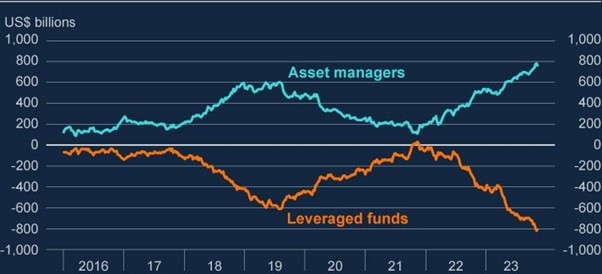13/12/2023
Should we fret about the Treasury basis trade?

In short, regulators are watchful; but it’s less clear if market participants are facing another doomsday. A hedge fund trade that nearly led to a meltdown in 2020 is still a problem for financial markets, the Bank of England’s Financial Policy Committee says in its latest Financial Stability Report (FSR). It’s far from alone in this concern.
In recent months global regulators have been starting to voice concerns over the building up of positions in the US Treasury market by hedge funds; a trade which played a large part in exacerbating the Treasury market turmoil in 2020’s scramble for dollars during the height of the pandemic panic – which prompted unprecedented intervention by the Fed. This issue has gained further attention during the rate hiking cycle this year which led, at least in part, to the banking crisis in the US.
Here’s the FPC latest:
“Hedge fund net short positioning in US Treasury futures has recently increased, as asset manager net long positions have continued to grow…”
The trade in question is a simple arbitrage of buying bonds and selling futures linked to the underlying bonds to exploit the difference in pricing. The cash-futures basis trade also involves borrowing in the repo market to finance the trade and provide leverage.
FPC explainer on the trade:
“As an alternative to investing directly in US Treasury bonds, asset managers can gain similar exposures via futures contracts linked to the underlying bonds. The synthetic leverage provided by futures requires less initial cash outlay, freeing up resources for other purposes, such as meeting redemptions or investing in higher yielding assets. This demand for futures pushes up their prices relative to the prices of corresponding cash bonds. The ‘cash-futures basis trade’ exploits these price differences. In normal market conditions, the basis trade plays a useful role by intermediating between different types of market participants, helping to keep the cash and futures markets broadly aligned, thus improving market liquidity and efficiency.”
But… this opens up financial stability risks when markets move quickly – not unlike the blow up in LDI in UK gilts, which became a problem due to the speed of the selling and self-reinforcing doom loop. Only this time it’s the far larger market for US government bonds.
Back to the FPC: “This intermediation can, however, amplify market stress. To boost returns, hedge funds tend to use significant amounts of leverage, supported by short-term borrowing in the repo market. And relatively low initial margin requirements for the futures contracts enable potentially high degrees of leverage. Sharp increases in volatility in market interest rates could lead to increases in margin required on the futures positions, or hedge funds may find it harder to refinance their borrowing in the repo market. This, combined with any breaches of risk- or loss-limits, could force funds rapidly to unwind their positions (as seen in the March 2020 ‘dash for cash’ episode), which could amplify the market volatility.”
Since the July report, hedge funds’ net short positioning in US Treasury futures has increased further, from around $650 billion to around $800 billion, based on hedge fund Treasury short positioning data as the proxy.
This now exceeds in nominal terms its size prior to the 2020 market stress. This trend has, as expected, largely mirrored asset managers’ increased net long positioning.
Chart 5.1: Hedge fund net short positioning in US Treasury futures has recently increased further, as asset manager net long positions have continued to grow

The FPC notes:”…and although the recent volatility in rates has not crystallised financial stability risks, vulnerabilities associated with it remain.”
The FPC is not by any means alone in fretting about the Treasury basis trade.
The Fed notes that “sustained large exposures by hedge funds present a financial stability vulnerability”.
The Bank for International Settlements says “the current build-up of leveraged short positions in US Treasury futures is a financial vulnerability worth monitoring because of the margin spirals it could potentially trigger”. It was warning in September that speculative positions by leveraged investors in US Treasuries were “back” and comparable to the level of net shorts in the run-up to the repo market turmoil of September 2019 and the US Treasury market dislocations of March 2020.
The good news for now is that ‘structural changes’ could have mitigated some of the vulnerabilities associated with the trade since 2020, says the FSR.
“Higher initial margin requirements on Treasury futures, in response to increased market volatility, have had the effect of reducing the effective (synthetic) leverage available to market participants, since more cash is required upfront for a given level of exposure.”
For example, the FSR notes that estimates that leverage in 5yr Treasury futures has fallen from around 175x prior to the pandemic to around to 70x.
“Nonetheless it remains an important vulnerability which continues to be monitored by the FPC,” the FSR continues. “There are potential spillover risks to the UK. These could be via the participation of the same hedge funds in both US Treasury and gilt markets, and also more indirectly via disruption to the systemically important US Treasury market.”
Neil Wilson Chief Market Analyst at Finalto
All opinions, news, research, analysis, prices or other information is provided as general market commentary and not as investment advice and all potential results discussed are not guaranteed to be achieved. The information may have been derived from publicly available sources, company reports, personal research, or surveys. Past performance is not indicative of future performance. Trading carries risk of capital loss. Service available to professional clients only.
Related News & Events

Finalto attending iFX EXPO Asia 2025 as Platinum Sponsors

Countdown to iFX EXPO Asia 2025: Q&A with Mallika Tan

Gold and the Zeitgeist: Searching for the Meaning Behind the Surge

